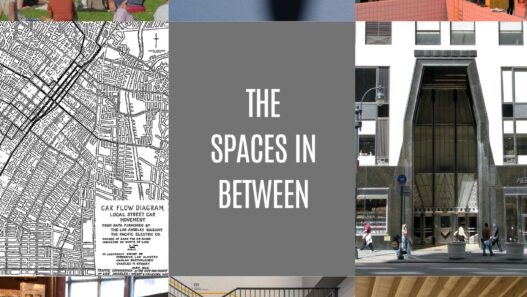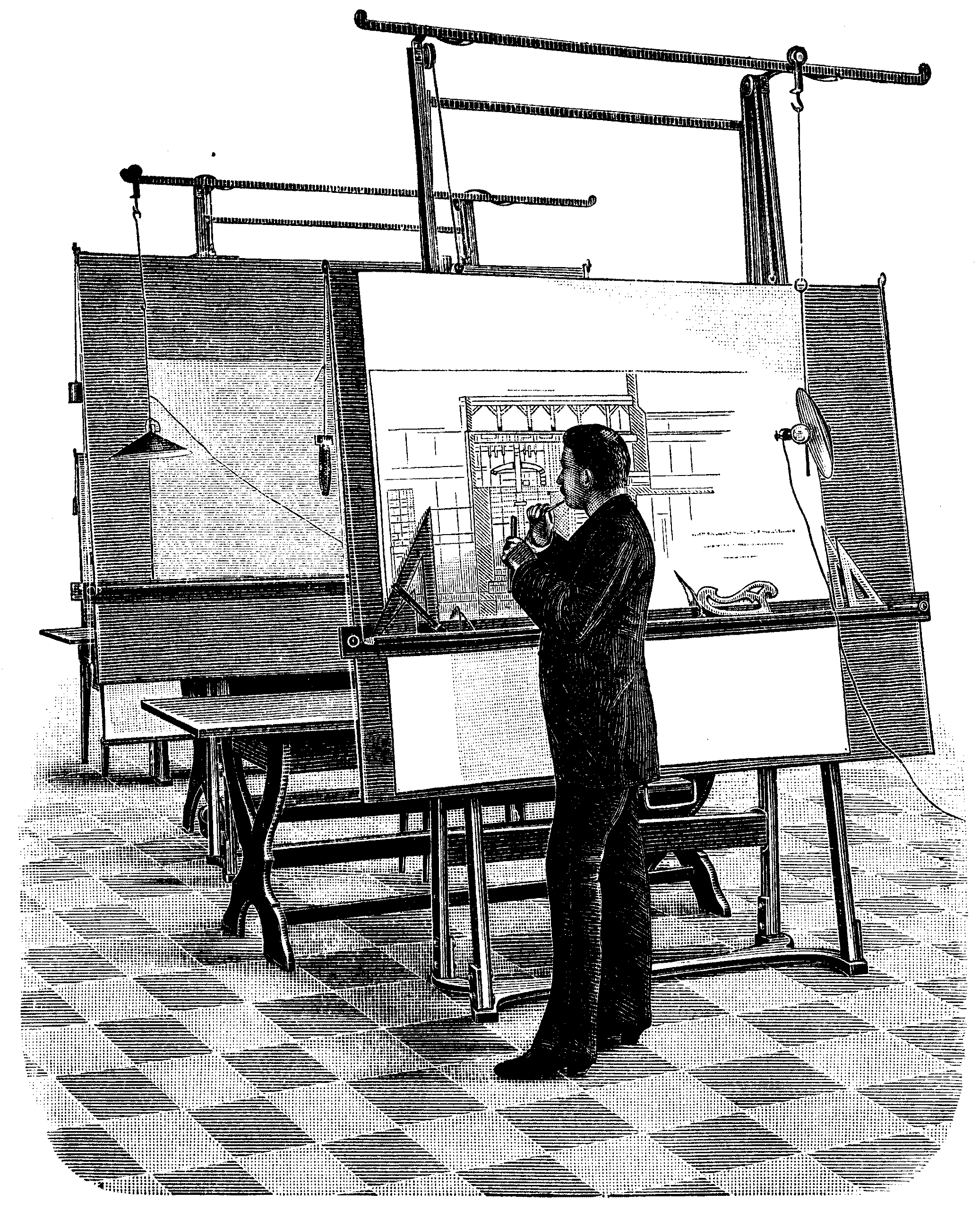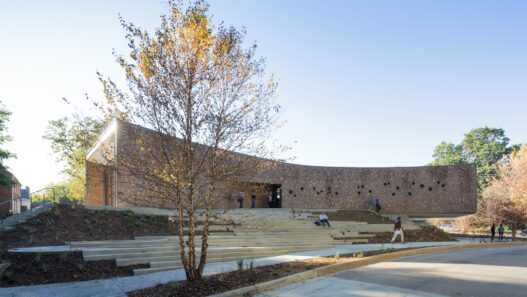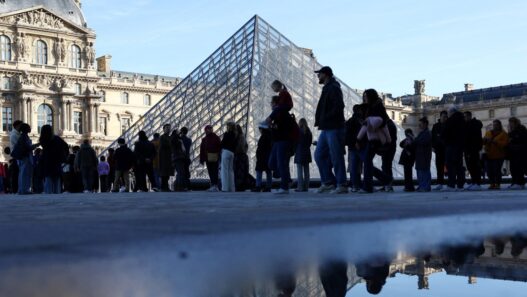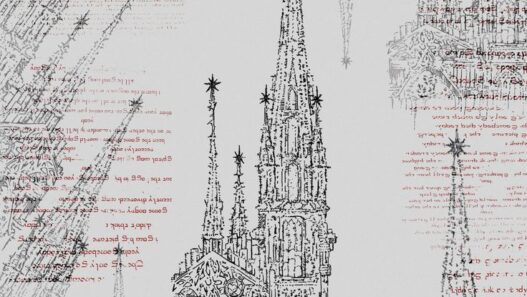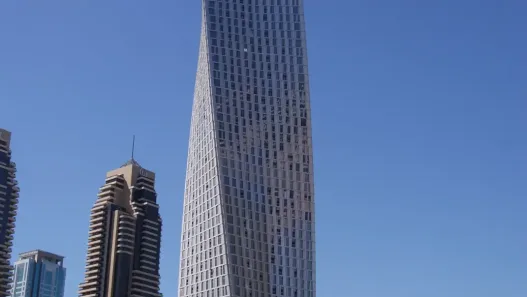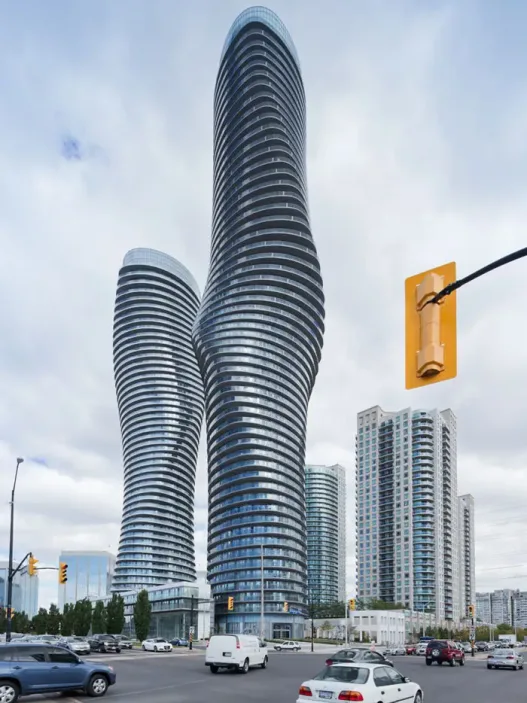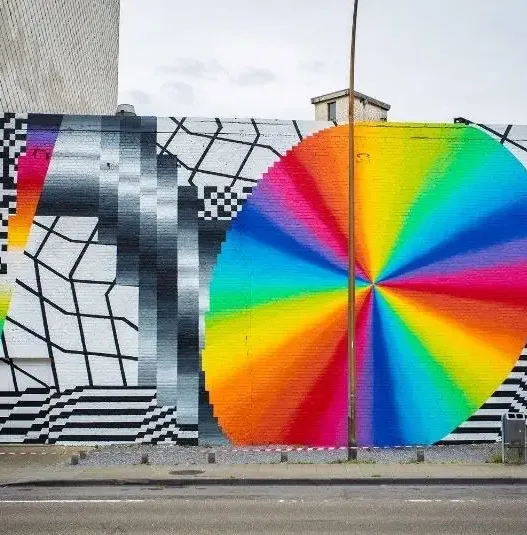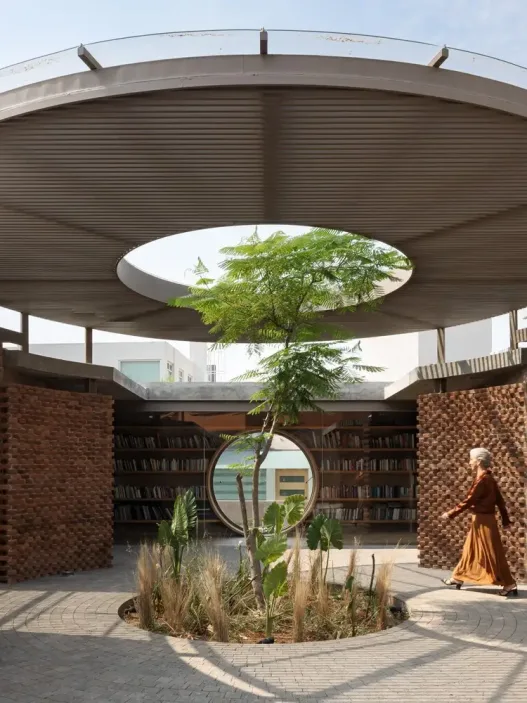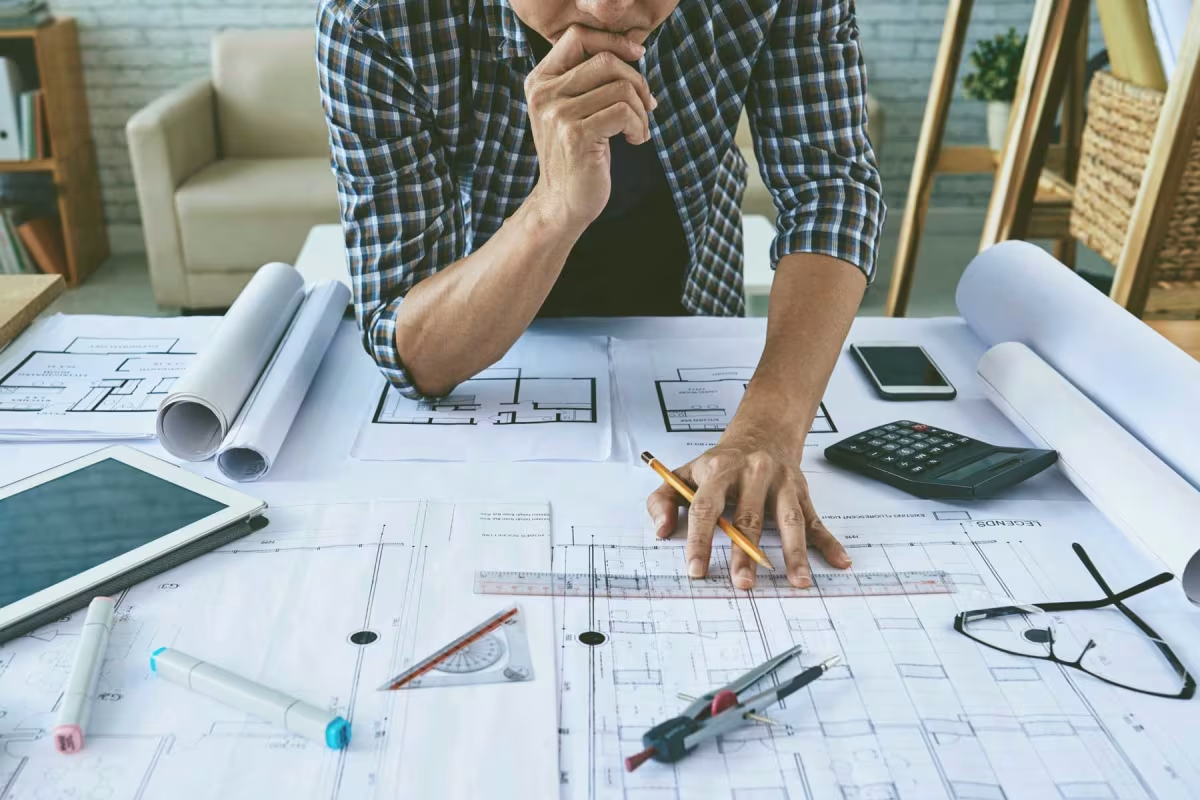Infinity Tower stands as a remarkable testament to contemporary architectural innovation and vision. Rising majestically on the skyline, the tower not only redefines urban living, but also demonstrates how architecture can be both functionally and aesthetically pleasing.
- Location: Infinity Tower is located in Dubai, United Arab Emirates.
- Architect: The tower was designed by architect David Fisher.
- Year of Completion: The construction of the tower started in 2006.
- Architectural Style: The design has a modern and innovative approach with dynamic twisting elements.
- Height: The tower is planned to reach a height of approximately 420 metres (1,378 feet).
- Twisting Design: Each floor of the tower rotates 90 degrees, creating a unique spiral effect.
- Sustainability: The building is designed to be environmentally friendly, incorporating wind turbines and solar panels for energy generation.
- Mixed Use Functionality: Infinity Tower will include residential apartments, hotels and office spaces.
- Construction Technique: The tower utilises a modular construction method that allows for the rapid assembly of prefabricated units.
- Cultural Significance: Infinity Tower aims to redefine urban architecture and is expected to be a landmark in Dubai’s skyline.
This introduction discusses the project’s background, location, conceptual framework, its importance in modern architecture and the awards it has received.

Project Overview
The Infinity Tower, also known as Burj Khalifa in some contexts, is an ambitious skyscraper stretching skywards with its unique curved design. Completed in 2010, it is one of the tallest buildings in the world with a height exceeding metres. The building is not just an engineering marvel; it represents a lifestyle and a vision for the future of urban living, integrating residential, commercial and hospitality spaces with its soaring form. Using sustainable technologies, the design meets the needs of the residents while minimising environmental impact.
Location and Context
Located in the heart of Dubai, Infinity Tower benefits from its prime location in the centre of a bustling metropolis thriving with commerce, tourism and culture. The base of the tower merges seamlessly with the surrounding developments, including parks, shopping centres and entertainment venues, creating a vibrant urban hub. The context of the building is important; it is not just an isolated structure, but part of a larger narrative that signals Dubai’s rapid growth and ambition to become a global city. The architectural landscape of the area complements the tower with modern designs reflecting a blend of tradition and futurism.
Concept and Vision
The vision behind Infinity Tower is based on the desire to create a landmark that transcends traditional architectural boundaries. The curvilinear design symbolises unity and connection, representing the intertwining of cultures and ideas. Each floor of the tower is designed to offer unrivalled views of the city, enhancing the experience of living and working within its walls. The concept also emphasises sustainability with features such as energy-efficient systems and green spaces that encourage a healthy lifestyle. Infinity Tower is not just about height; it is about redefining what a skyscraper can be in the 21st century.
Significance in Modern Architecture
Infinity Tower has an important place in the narrative of modern architecture. It challenges traditional notions of skyscraper design, pushing the boundaries of what is possible. The use of advanced engineering techniques and materials sets a new standard for future projects. Its iconic silhouette has become a symbol of Dubai’s architectural prowess and a source of inspiration for architects around the world. The tower is an important case study in architectural education and practice, exemplifying how innovative design can create functional living spaces while enhancing the urban landscape.
Awards and Recognition
Infinity Tower’s architectural brilliance has not gone unnoticed. It has received numerous awards and accolades celebrating its design, sustainability efforts and overall impact on the urban environment. Commendations from prestigious organisations highlight its significance as a modern architectural marvel. The tower frequently features in global debates on the future of urban design and serves as a benchmark for aspiring architects and developers. Its legacy continues to inspire projects around the world as a milestone in the evolution of skyscraper design and urban development.
Ultimately, Infinity Tower is much more than a building; it is a symbol of human ingenuity and ambition. Its design, context and significance reflect a forward-thinking approach to architecture that prioritises sustainability, community and innovation. As cities around the world continue to grow, the lessons learnt from Infinity Tower will undoubtedly shape the future of urban architecture.
Architectural Design Features
Architectural design is a fascinating blend of art, science and technology and shapes the way we interact with our built environment. It influences not only the aesthetics of a building, but also its functionality and sustainability. As we explore various architectural design features, we will uncover innovative approaches that enhance our living spaces while respecting the planet and its resources.
Twisted Design and Structural Innovation
In architecture, twisted design refers to dynamic forms and shapes that challenge conventional building structures. This innovative approach often creates visually striking results by combining elements that appear to defy gravity. One of the most notable examples is the “Spinning Body”, a residential skyscraper in Malmö, Sweden, that spirals upwards. This design is not only pleasing to the eye, but also serves practical purposes such as maximising views and light for residents.
The structural innovation behind twisted designs often involves advanced engineering techniques and materials. Architects and engineers collaborate to ensure that these buildings can withstand environmental pressures while retaining their unique form. For example, the use of reinforced concrete and steel provides greater flexibility and durability, allowing such complex shapes to be built. This innovative spirit not only enhances the skyline, but also inspires future generations to think beyond traditional boundaries.
Material Selection and Sustainability
The materials chosen in architectural design play a crucial role in determining the environmental impact and sustainability of a building. Architects today are increasingly aware of the need to use resources responsibly. Sustainable material selection involves choosing renewable, recyclable and non-toxic materials that minimise their ecological footprint.
Bamboo, for example, is gaining popularity as a building material due to its rapid growth and durability. It is not only an aesthetically pleasing option, but also a sustainable choice that reduces deforestation. Furthermore, the use of reclaimed wood and recycled metals can add character to a building while promoting resource efficiency. Innovations in concrete, such as self-healing concrete that repairs its cracks, exemplify how materials science is advancing sustainability in architecture.
Furthermore, the integration of green roofs and living walls demonstrates how materials can support biodiversity and improve air quality. These features not only increase the aesthetic appeal of the building, but also make urban areas more liveable by creating habitats for various species.
Interior Planning
Effective interior space planning is essential for creating functional and inviting environments. This aspect of architectural design involves the thoughtful arrangement and organisation of spaces to enhance the user experience. Consideration is given to how people will move through a space, how they will interact with each other, and how they will use various spaces for different purposes.
For example, open floor plans have become a popular trend in residential design. These plans promote a sense of community and allow natural light to flow freely throughout the space. However, effective interior planning also requires balancing openness with privacy. Architects often achieve this through the strategic placement of walls, furniture and partitions, making spaces feel both connected and cosy.
In commercial environments, interior space planning can significantly impact productivity and employee satisfaction. Thoughtfully designed workspaces that include co-working spaces, quiet zones and relaxation areas contribute to a healthier work-life balance. Real-world applications such as Google’s offices exemplify how innovative interior design can foster creativity and collaboration among employees.
Facade and Aesthetic Appeal
The facade of a building is its face; it communicates its identity and purpose to the world. Aesthetic appeal in architectural design is not only about beauty; it also reflects cultural values and historical contexts. The facade can tell a story, evoke emotions and create an immediate connection with passers-by.
Modern architecture often adopts bold materials and striking forms to create eye-catching facades. For example, the use of glass not only provides transparency, allowing natural light to flood the interiors, but also symbolises openness and modernity. In contrast, traditional buildings may use brick or stone to give a sense of permanence and stability.
Architects are increasingly exploring how facades can improve energy efficiency. Innovations such as dynamic facades that adapt to sunlight conditions are helping to regulate temperature and reduce energy costs. The Al Bahar Towers in Abu Dhabi feature a responsive facade that opens and closes to control heat and glare, demonstrating how aesthetics can be harmoniously blended with functionality.
Integration with the surrounding environment
Successful architectural design takes into account the surrounding environment and seeks to integrate seamlessly with it. This approach encourages harmony between buildings and their surroundings, reflecting respect for nature and the local context. Architects often analyse the geographical, cultural and historical aspects of an area to inform their design.
For example, Frank Lloyd Wright’s Fallingwater house is a sign of this integration. Built on a waterfall in Pennsylvania, the house uses natural materials that harmonise with the forested environment. The design emphasises the relationship between the structure and its surroundings, making residents feel connected to nature.
Furthermore, contemporary projects often incorporate sustainable practices such as rainwater harvesting systems and solar panels to reduce their ecological footprint. By aligning architectural design with environmental principles, architects create spaces that are not only visually appealing, but also responsible and resilient, nurturing the ecosystems in which they exist.
As a result, architectural design features are vital in shaping our built environment. From innovative structures that are constantly evolving to sustainable material choices, interiors that encourage community, facades that tell stories, and designs that integrate with nature, each element plays a crucial role in enhancing our experiences. Moving forward, embracing these concepts will be crucial in creating spaces that are not only beautiful but also sustainable and functional.
Construction Process
The construction process is a complex journey that transforms ideas and plans into concrete structures. It involves meticulous planning, co-ordination and execution, all aimed at creating buildings and infrastructure that meet the needs of society. Understanding this process is essential for anyone involved in architecture, engineering or project management as it encompasses various stages, challenges and innovations.
Development Timeline
The development timeline in construction can vary significantly depending on the type and scale of the project. It usually starts with pre-construction activities such as site analysis, feasibility studies and obtaining permits. This phase can last several months or even years, depending on regulatory requirements and the complexity of the design.
Once all the necessary approvals have been obtained, the project moves on to the construction phase, which can range from a few months for smaller projects to several years for larger developments such as skyscrapers or bridges. During this time, various tasks are carried out in sequence. First the foundation is laid, then the structural framework, installations for the plumbing and electrical systems and finally the finishing touches such as interior design and landscaping. To avoid delays and keep the project on track, each phase must follow a carefully prepared programme.
Real-world examples, such as the construction of One World Trade Centre in New York, vividly illustrate this timeline. The project faced numerous obstacles from its inception to its completion in 2013, but was meticulously planned to ensure a smooth development process.
Key Challenges Faced
Every construction project, regardless of size or scope, faces challenges. One of the most significant obstacles is managing unforeseen conditions, such as adverse weather or unexpected geological issues. For example, when building on a site with difficult soil conditions, crews may need to change their foundation plans, leading to delays and increased costs.
Another common challenge is resource management. Coordinating the supply of materials and labour is critical. Delays in material delivery can halt a project, affecting the overall timeline and budget. It is also essential to maintain effective communication between all stakeholders – architects, contractors and clients. Misunderstandings can lead to mistakes that may require costly rework.
Safety is also a very important issue; construction sites are inherently dangerous. Ensuring that all employees are trained and safety protocols are followed is crucial to prevent accidents that can lead to injuries and project delays.
Technology and Techniques Used
Advances in technology have revolutionised the construction process, making it more efficient and cost-effective. Building Information Modelling (BIM) is one of the most important innovations in recent years. This digital tool allows architects and engineers to create 3D models of buildings, enabling better visualisation and collaboration. With BIM, potential problems can be identified and solved before construction starts, thus reducing errors and saving time.
In addition, modular construction techniques are gaining popularity. This method involves prefabricating sections of a building off-site and then quickly assembling them on-site. This approach not only speeds up construction time, but also minimises waste and improves quality control.
Real-time project management software is also becoming important. These tools help track progress, manage resources and facilitate communication between all parties involved, ensuring that everyone is on the same page.
Collaboration with Engineers and Contractors
The construction process is a collaborative endeavour that requires seamless co-operation between architects, engineers, contractors and various specialists. Each group brings unique expertise and perspectives to the table. Architects envision design and aesthetics, while engineers focus on the structural integrity and functionality of the building.
Effective co-operation begins in the early stages of design. Regular meetings and discussions enable all parties to harmonise their goals and address potential challenges. For example, a structural engineer may suggest design changes to improve safety and stability, and architects need to make these changes without compromising artistic vision.
This teamwork extends to the construction phase, when contractors implement the plans. Open lines of communication are crucial here; if a problem arises, quick discussions can lead to immediate solutions and avoid delays. Successful projects such as the Sydney Opera House are prime examples of effective collaboration, demonstrating how different expertise can lead to ground-breaking results.
Safety Measures Implemented
Safety in construction cannot be ignored. It is a fundamental aspect of the entire process and ensures the well-being of workers and the public. Comprehensive safety plans are developed before any construction begins. These plans outline protocols for various scenarios, including emergency procedures, equipment utilisation and site access.
Regular safety training is mandatory for all employees. This training covers basic topics such as the proper use of personal protective equipment (PPE), awareness of potential hazards, and safe machine operation. In addition, construction sites often have safety officers who monitor compliance with regulations and address concerns promptly.
Innovations in safety technology are increasing, such as wearable devices that monitor workers’ health and fatigue levels. These tools can alert supervisors to potential problems before they become emergencies. Furthermore, implementing strict safety protocols not only protects workers, but also improves overall project efficiency as fewer accidents lead to less downtime.
In summary, the construction process is a multi-faceted journey full of challenges and innovations. By understanding the timeline, the obstacles encountered, the technology used, the importance of collaboration and the safety measures implemented, we can better grasp the intricacies of building our world. Every construction project is a testament to human creativity and the collective endeavour to create spaces that improve our lives.
Cultural and Social Impact
Architecture is more than the design of buildings; it is a mirror that reflects the values, beliefs and needs of society. The cultural and social impact of architecture shapes societies, influences urban spaces and strengthens bonds between people. It plays a vital role in community engagement, urban development, tourism, artistic expression and education. Each element interacts with the others to create a rich tapestry that defines how we experience our environment.
Community Engagement and Responses
Architecture has the power to bring communities together in meaningful ways. When a new building is proposed, it often sparks discussions between residents, architects and urban planners. These discussions can lead to a greater sense of ownership and pride among community members. For example, community centres designed with input from local people not only meet the practical needs of the neighbourhood, but also reflect its cultural identity.
Participation goes beyond mere consultation. It involves participatory design processes where residents contribute with ideas and feedback. This collaborative approach can lead to innovative solutions that may not emerge in a traditional top-down design process. When people feel listened to and included, they are more likely to embrace the resulting architecture and its role in their community.
Impact on Urban Development
Architecture significantly influences urban development by shaping the physical layout and social dynamics of cities. Key structures such as transport hubs, parks and mixed-use developments can transform neighbourhoods. For example, a well-planned public transport station can revitalise an area, making it more accessible and attracting both businesses and residents.
Furthermore, iconic buildings can become landmarks that define a city’s identity. The Sydney Opera House not only beautifies the waterfront with its unique sail-like design, but also attracts visitors from around the world. Such structures create a sense of place, influencing the way people interact with their environment and with each other.
Urban development also addresses pressing social issues such as housing shortages and sustainability. Thoughtful architecture can provide affordable housing solutions while incorporating green spaces that enhance quality of life. As cities develop, the architectural response to these challenges can foster communities that are both vibrant and sustainable.
Role in Promoting Tourism
Tourism is often driven by the architectural heritage of a destination. Historic buildings, modern masterpieces and unique structures attract visitors keen to explore and experience the local culture. Cities such as Barcelona, famous for Antoni Gaudi’s whimsical designs, show how architecture can be a major attraction for tourists.
In addition to its historical significance, contemporary architecture can also play an important role in tourism. Museums, hotels and other attractions designed with creativity and cultural relevance can increase the attractiveness of a city. For example, the Guggenheim Museum in Bilbao has revitalised the city, transforming it into a cultural attraction and significantly boosting its economy.
Architectural tours, whether guided or self-guided, allow tourists to engage with a city’s narrative through buildings. These experiences create lasting impressions that contribute to the tourism economy by enriching understanding and appreciation of local culture, history and art.
Artistic Collaborations and Installations
Architecture often intersects with art, leading to exciting collaborations that enhance public spaces. Artists and architects can work together to create installations that transform ordinary environments into extraordinary experiences. This synergy can take many forms, from murals on building facades to sculptures in public squares.
Artistic installations not only beautify spaces, but also provoke thought and dialogue among viewers. For example, “The Vessel” in New York, designed by Heatherwick Studio, is an interactive structure that invites visitors to explore its honeycomb-like design. Such projects encourage participation, making art an integral part of the architectural experience.
Furthermore, temporary installations and public art projects can stimulate participation and collaboration between local artists, architects and residents by enlivening spaces during festivals or community events. These initiatives can breathe new life into neighbourhoods and create vibrant cultural hubs that celebrate creativity.
Education Programmes and Outreach
Architecture also plays an important role in education, serving as a tool for outreach and engagement. Educational programmes focusing on architecture can inspire young minds to explore the built environment and its impact on society. Workshops, lectures and hands-on activities can demystify architecture and encourage students to think critically about their environment.
Schools and community organisations often collaborate with architects to develop programmes that emphasise design thinking and spatial awareness. By engaging students in projects such as designing a community garden or playground, they learn valuable skills such as teamwork, problem solving and creativity.
Architecture can also serve as a platform for discussion of broader social issues such as sustainability and inclusion. Programmes highlighting these themes can empower individuals to envision a better future through thoughtful design and community engagement. Through education, architecture becomes not just a profession but a catalyst for change, inspiring a new generation of thinkers and creators.
As a result, the cultural and social impact of architecture is profound and multifaceted. It shapes communities, influences urban development, promotes tourism, fosters artistic collaborations and increases access to education. As we continue to build and innovate, understanding the wider implications of architectural design is essential to creating spaces that resonate with people and enrich their lives.
Visitor Experience
Creating unforgettable visitor experiences is a must for every architectural marvel. The journey through a building or site is often as important as the structure itself. When we think about how people engage with a place, we uncover a tapestry of guided tours, stunning views, accessible facilities, exciting events and personal stories. This section examines these elements in detail and highlights how each contributes to an enriching visitor experience.
Guided Tours and Accessibility
Guided tours are a vital aspect of the visitor experience, providing insights that may be overlooked during a casual visit. Knowledgeable guides share stories about the architecture, its history and the vision behind its creation. These narratives bring the building to life, making it more than just a collection of walls and windows. At the Sydney Opera House, for example, guides take visitors through the building’s unique journey, describing the challenges faced during its construction.
Accessibility is another important component. A well-designed visitor experience ensures that everyone can enjoy the space, regardless of their physical abilities. This means implementing features such as ramps, lifts and tactile guides. For example, the Louvre Museum in Paris has taken important steps in this area and offers specialised tours for people with mobility difficulties. By prioritising accessibility, sites increase their appeal and ensure that every visitor can relate to the architecture.
Observation Terrace and Views
Observation decks serve as the pinnacle of the visitor experience, offering breathtaking panoramas that reveal the beauty of the surrounding landscape. These vantage points allow visitors to appreciate the architecture in the context of its surroundings. The Empire State Building’s observation deck, for example, offers a stunning view of New York City, allowing guests to see how the building interacts with the skyline and urban fabric.
These spaces are designed not only for viewing, but also to create a sense of awe. They often include interactive displays or telescopes that invite visitors to engage more deeply with what they see. On a clear day, the view from the hilltop can inspire feelings of curiosity and connection to the larger world, turning a simple visit into a memorable experience.
Amenities and Facilities
Well-appointed amenities can significantly enhance a visitor’s experience. From clean toilets to cosy seating areas and cafés, these facilities contribute to the overall enjoyment of a site. Imagine exploring a large museum and finding a cosy café where you can relax and reflect on the artworks you see. Such spaces encourage visitors to linger, allowing them to connect more deeply with their surroundings.
In addition, souvenir shops and educational centres can also provide valuable resources. They offer souvenirs that serve as tangible reminders of the visit, while educational materials can spark a new interest in architecture or history. For example, the Guggenheim Museum in New York not only showcases stunning works of art, but also has a well-curated gift shop that reflects its artistic ethos. The facilities ensure that the visitor experience is comfortable, enriching and memorable.
Organised Events and Activities
Hosting events and activities transforms architectural spaces into dynamic cultural centres. From art exhibitions to concerts and community gatherings, these events enable buildings to serve a dual purpose: as architectural masterpieces and as vibrant social spaces. The Tate Modern in London is a case in point, frequently hosting public events such as workshops, film screenings and talks with artists.
These events not only attract new visitors, but also deepen the relationship between the community and the building. When people come together in a space for a common purpose, they create memories that resonate long after the event is over. This participation encourages a sense of ownership and pride in the architecture, making it a valued part of the community.
Visitor Comments and Evaluations
The stories and experiences of past visitors can provide invaluable insight into how a place is perceived. Testimonials and reviews often highlight what people loved about their visit, from the architectural details they found striking to the emotional impact of the experience. For example, visitors to the Colosseum in Rome may describe standing in awe at the splendour of ancient engineering, while others may talk about the emotional weight of walking through a site steeped in history.
These personal accounts not only guide potential visitors, but also help architects and planners understand what resonates most with the public. By listening to feedback, they can improve future experiences and ensure that architecture continues to inspire and delight. Ultimately, the voices of visitors enrich the narrative of a building, making it a living part of society.
The Future of the Infinity Tower
Infinity Tower stands as a beacon of architectural innovation and a symbol of modern urban living. Looking to the future, exploring its potential in various aspects such as maintenance, expansion, architectural trends, smart city initiatives and its vision for the next decade reveals how this structure can adapt and evolve in a rapidly changing world. Each of these areas not only reflects the significance of the tower, but also demonstrates its potential to influence the wider architectural landscape.
Long Term Care and Conservation
The long-term maintenance and preservation of Infinity Tower is crucial to its sustainability and longevity. As an iconic structure, the Infinity Tower is not just a building; it represents a commitment to architectural excellence and cultural heritage. Regular maintenance is essential to ensure that the materials used in its construction remain resistant to weather, pollution and the passing of time.
The use of advanced materials in the tower’s construction, such as self-healing concrete and energy-efficient glass, plays a vital role in minimising maintenance needs. These materials can reduce the frequency of repairs while contributing to the environmental sustainability of the building. Furthermore, the implementation of a comprehensive monitoring system can help to identify potential problems before they become major issues. Such proactive measures can extend the lifespan of the structure while preserving its aesthetic and functional qualities.
Preservation also involves interaction with the community. By hosting events and educational programmes, Infinity Tower can maintain its relationship and connection with the people it serves. This relationship fosters a sense of ownership and pride among residents, encouraging collective efforts to maintain the building.
Potential for Expansion or Renovation
As the urban landscape evolves, the potential for expansion or refurbishment of Infinity Tower becomes increasingly important. Cities are dynamic; they grow and change, often requiring adjustments to existing structures to meet new demands. Infinity Tower is well positioned to adapt to these changes with its innovative design and flexible spaces.
The refurbishment provides an opportunity to update facilities, integrate modern technologies and improve energy efficiency. For example, the use of renewable energy sources such as solar panels or wind turbines can further reduce the carbon footprint of the tower, making it a model for sustainable architecture. Furthermore, redesigning the public spaces in or around the tower could increase community engagement and social interaction in line with contemporary urban planning principles.
Expansion could also include the addition of new wings or floors, provided that it is done thoughtfully to preserve the tower’s iconic silhouette. This adaptability speaks to the tower’s design philosophy, which emphasises the balance between innovation and tradition. Infinity Tower can serve as a case study for future projects by showing how buildings can evolve without losing their essence.
Impact on Future Architectural Trends
Infinity Tower has the potential to significantly influence future architectural trends. Its design, characterised by flowing shapes and integrated natural elements, reflects the growing trend towards biophilic design, an approach that aims to connect buildings with nature. As urban areas become more congested, the need for architecture that enhances well-being through natural elements is crucial.
Furthermore, the tower’s use of the latest technology demonstrates how digital tools can transform the design and construction processes. Techniques such as parametric design and 3D printing allow architects to create more complex forms and optimise materials, paving the way for more innovative structures.
As sustainability remains a priority, Infinity Tower’s emphasis on energy efficiency and environmentally friendly materials may encourage other architects and developers to adopt similar practices. This shift towards sustainable design is not just a trend, but a necessary response to the environmental challenges facing urban centres today.
Role in Smart City Initiatives
Infinity Tower is ideally positioned to play an important role in smart city initiatives. As cities become increasingly interconnected through technology, buildings like the Infinity Tower can serve as hubs for innovation and sustainability. Smart technology can enhance the tower’s operations, from energy management systems that optimise resource use to advanced security features that ensure the safety of residents and visitors.
Integration with smart city frameworks can enable Infinity Tower to contribute to broader urban goals, such as reducing traffic congestion with intelligent transport solutions or improving waste management with smart systems. The tower can also act as a data collection point, providing valuable insights into city life and informing future planning and development.
Furthermore, the Infinity Tower can strengthen communication between residents and city authorities by encouraging community engagement through digital platforms. This link can empower citizens to participate in decision-making processes, fostering a sense of community and shared responsibility for the urban environment.
Vision for the Next Decade
Looking ahead to the next decade, Infinity Tower’s vision encompasses a mix of innovation, sustainability and community engagement. As urban populations grow and the challenges of climate change intensify, the tower must adapt to serve as a model for future developments. This vision includes becoming a centre for cutting-edge research and development in sustainable architecture and smart technologies.
Infinity Tower can host co-working spaces for startups focusing on green technology and foster innovation in line with its core values. In this way, it can develop a vibrant ecosystem that not only supports local businesses but also brings forward-thinking solutions to the city’s pressing problems.
The tower’s role as a cultural landmark should be emphasised. By hosting art exhibitions, performances and community events, it can continue to be a focal point for social interaction and cultural expression and reinforce its importance in the urban fabric.
The future of Infinity Tower is bright and full of possibilities. Its potential for maintenance, expansion, influencing architectural trends, integration into smart city initiatives, and forward-thinking vision all contribute to its promise as an icon of modern architecture. With careful planning and community involvement, Infinity Tower can continue to inspire future generations.
FAQ
1. What is the Infinity Tower?
The Infinity Tower is a curved skyscraper in Dubai, United Arab Emirates, recognised for its unique architectural design.
2. Who designed the Infinity Tower?
The tower was designed by architect David Fisher.
3. When did the construction of the Infinity Tower start?
The construction of the tower started in 2006, but is still under development.
4. What is the architectural style of the Infinity Tower?
The tower has a modern and innovative design with dynamic twisting elements.
5. How tall will the Infinity Tower be?
The planned height of the tower is approximately 420 metres (1,378 feet).
6. What is unique about the tower’s design?
Each floor of the Infinity Tower rotates 90 degrees, creating a stunning spiral effect.
7. How does Infinity Tower promote sustainability?
The building includes wind turbines and solar panels to generate energy, making it environmentally friendly.
8. What type of spaces will Infinity Tower contain?
The tower will house residential apartments, hotels and office space.
9. What construction method is being used for Infinity Tower?
The tower utilises a modular construction technique that allows prefabricated units to be assembled quickly.
10. Why is Infinity Tower culturally significant?
Aiming to redefine urban architecture, the tower is expected to be a landmark in Dubai’s skyline, showcasing innovation and modern design.
Reflections on the Tower of Eternity: Twisted Heights
An architectural marvel under construction in Dubai, Infinity Tower represents a groundbreaking achievement in modern design. Created by architect David Fisher, this innovative structure mesmerises with its striking twisting form that rotates 90 degrees on each floor, giving it a dynamic and fluid appearance. The tower is not just a skyscraper; it represents the future of urban architecture and showcases the potential of advanced engineering.
Scheduled to be approximately 420 metres (1,378 feet) high, Infinity Tower will redefine the Dubai skyline. Its glass and steel façade reflects contemporary aesthetics and promotes sustainability through the integration of wind turbines and solar panels. This commitment to eco-friendly design is a testament to the growing importance of sustainable architecture in urban environments.
Beyond its impressive height and unique design, Infinity Tower will house residential apartments, hotels and office space, becoming a multifunctional centre that encourages community interaction. The use of modular construction techniques allows for rapid assembly, further emphasising the innovative approach behind this project.
What are your thoughts on Infinity Tower? Do you believe its design successfully reflects a sense of modernity and sustainability? Is there a particular aspect of the tower that resonates with you or enhances your perception of architectural innovation? We invite you to share your views!
Architect: David Fisher
Architectural Style: Modern and Innovative
Year: 2006-2010
Location: Dubai, United Arab Emirates



